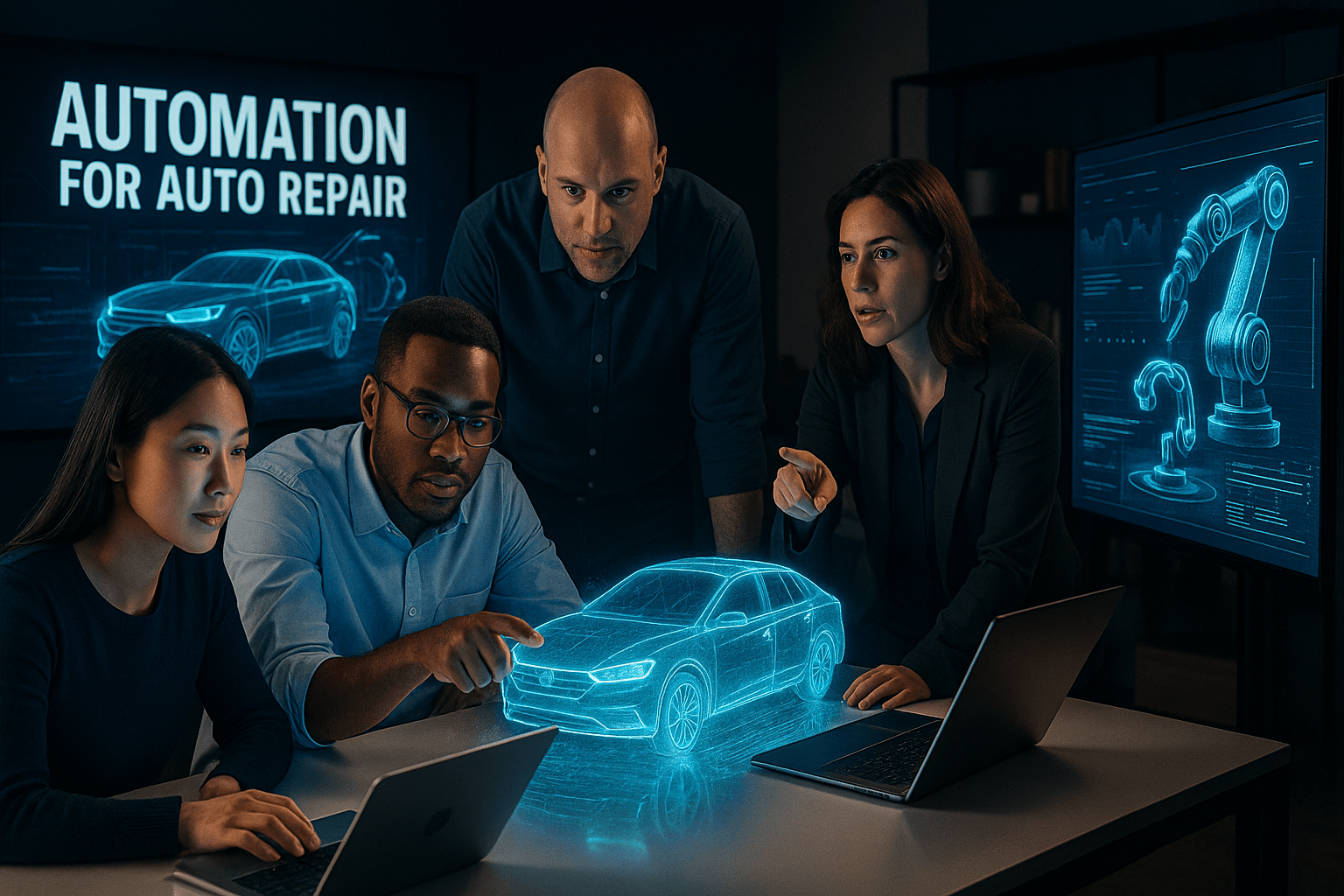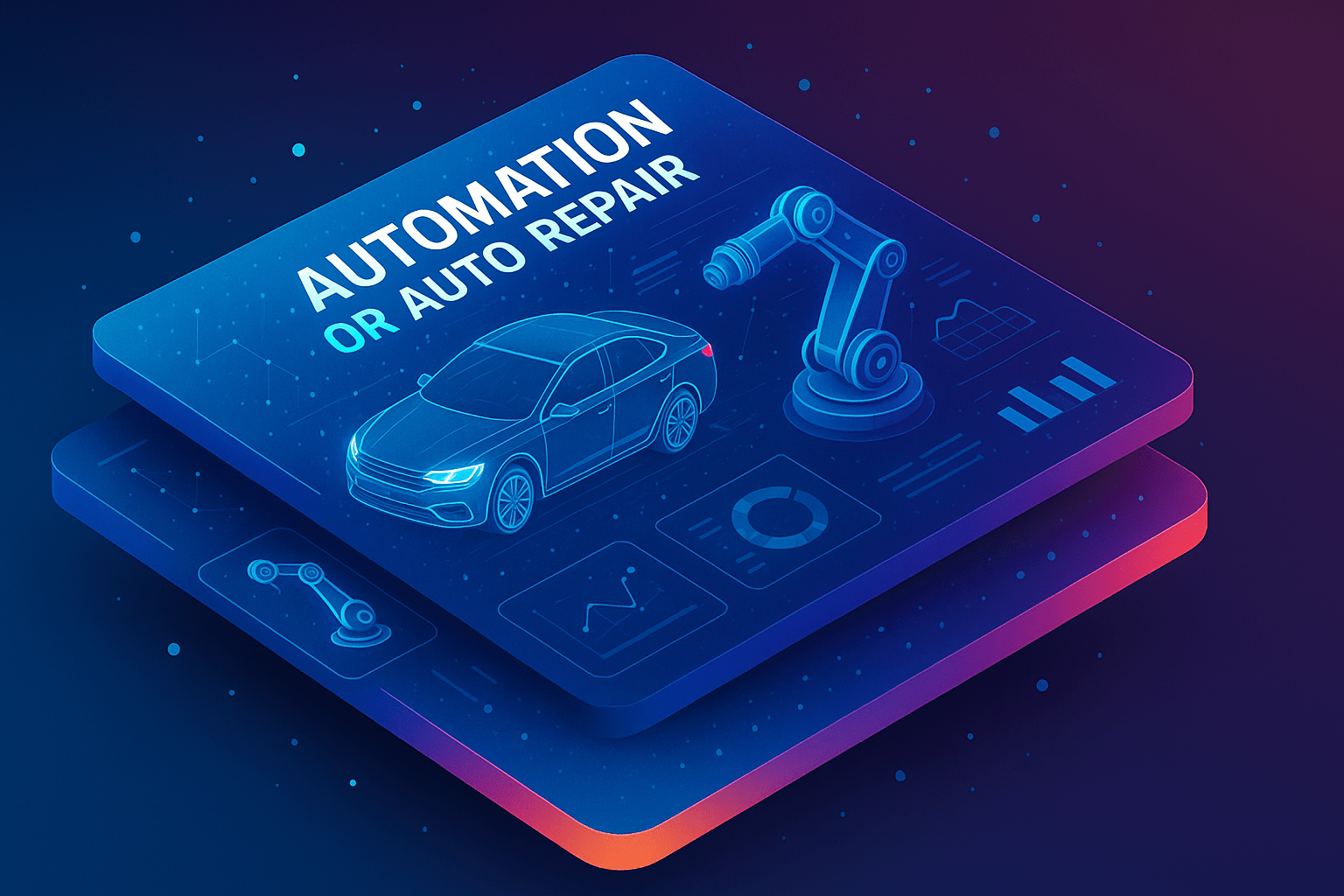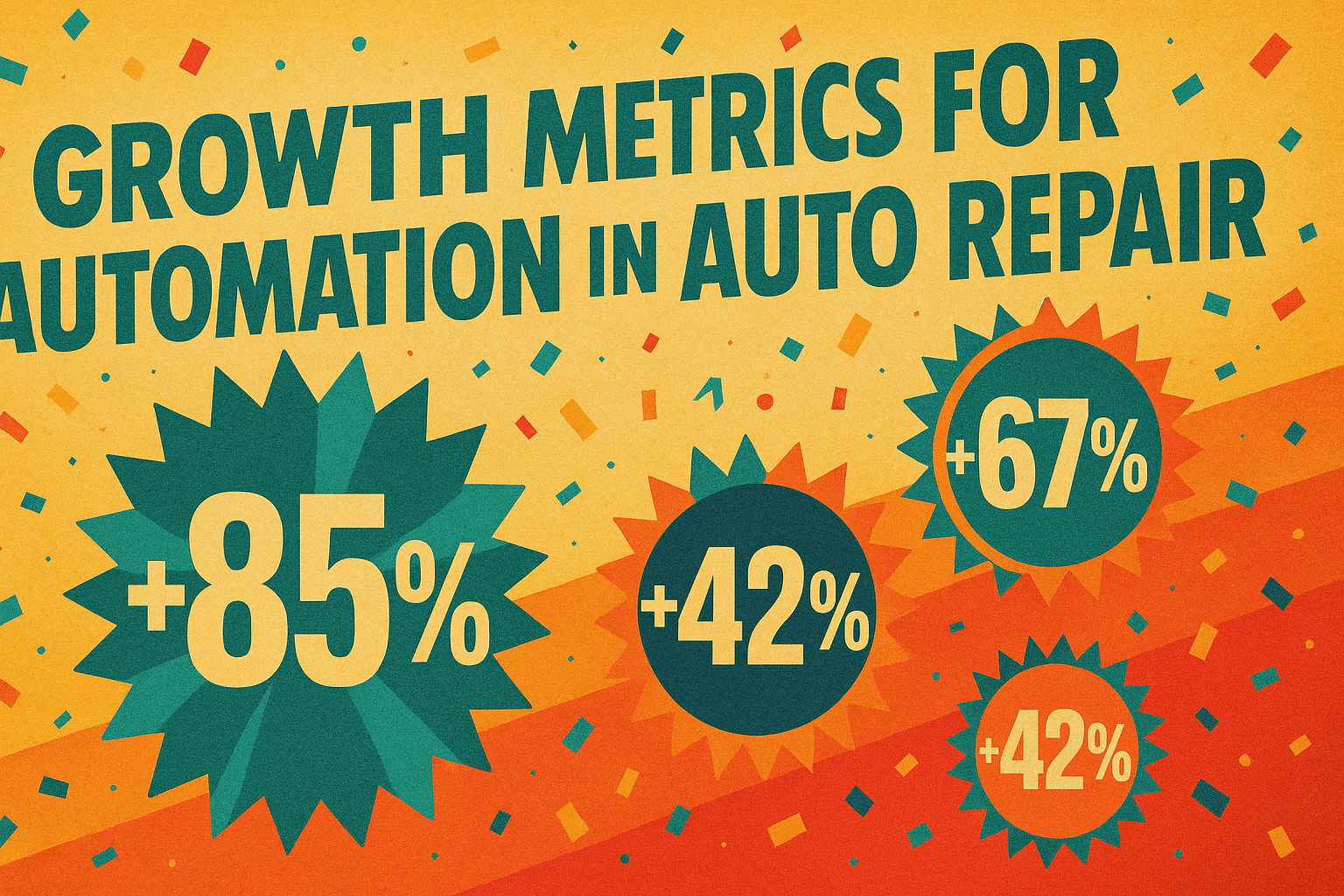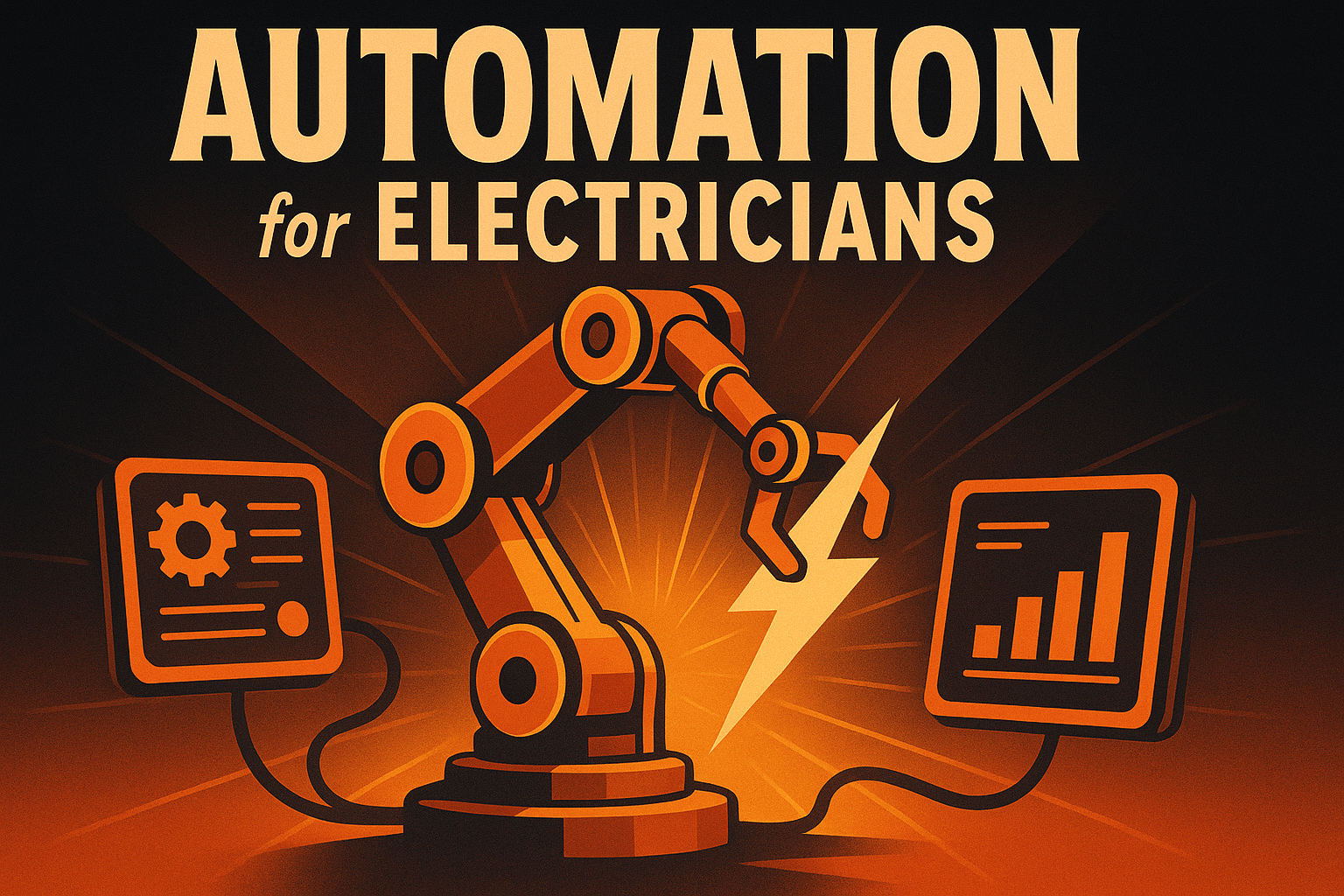Data-Driven Automation for Auto Repair: Eliminate Guesswork, Scale Faster
by Design Delulu Editorial · October 6, 2025

Stop losing customers to manual workflows and scattered data. Here's how intelligent automation transforms auto repair operations from reactive to revenue-generating.
Auto repair shops face a critical challenge: customer expectations have evolved faster than shop operations. Today's vehicle owners expect instant quotes, real-time service updates, seamless appointment scheduling, and transparent communication throughout the repair process. Meanwhile, most shops struggle with manual appointment booking, paper-based work orders, disconnected inventory systems, and zero visibility into which marketing channels actually drive profitable business. The result? Lost appointments, frustrated customers, technician downtime, and marketing budgets that disappear into black holes.
Data-led automation changes everything. When your auto repair shop connects customer touchpoints to operational workflows and ties every interaction back to measurable outcomes, you stop guessing and start growing. Automation for auto repair isn't about replacing skilled technicians or eliminating the human touch that builds customer loyalty. It's about eliminating the administrative friction that prevents your team from focusing on what they do best: exceptional automotive service. From the moment a potential customer searches for brake repair to the post-service follow-up that generates five-star reviews, automation ensures every step is tracked, optimized, and continuously improved based on real performance data.

Why Auto Repair Shops Need Automation Now
The auto repair industry operates on thin margins where every hour of technician time, every part markup, and every repeat customer directly impacts profitability. Yet most shops have no clear picture of their customer acquisition costs, service profitability by category, or which marketing investments actually generate appointments that show up and convert.
Manual processes create multiple failure points. Phone tag with customers delays approvals and extends repair timelines. Handwritten estimates get lost or misread. Inventory reordering happens reactively when parts run out instead of predictively based on service patterns. Marketing decisions rely on gut feeling rather than attribution data showing which channels drive qualified leads at acceptable costs.
Modern automation solves these problems by creating seamless workflows that connect every customer interaction to your operational systems and measurement infrastructure. When a customer books an appointment through your website, that action should automatically update your shop management system, send confirmation messages, trigger reminder sequences, and track back to the marketing source that drove the visit. When a technician completes a service, automation can request reviews, schedule follow-up maintenance, and update customer profiles without manual data entry.
The competitive advantage goes to shops that can respond faster, communicate more effectively, and make decisions based on comprehensive performance data rather than incomplete intuition.
Core Components of Auto Repair Automation Systems
Effective automation for auto repair shops requires integration across three critical layers: customer acquisition tracking, operational workflow automation, and unified performance measurement. Each layer builds on the others to create a complete system that drives sustainable growth.
Customer Acquisition & Attribution Tracking
Understanding how customers find your shop and which marketing channels deliver profitable business starts with comprehensive tracking infrastructure. This means implementing Google Analytics 4 with server-side tagging to capture every website interaction, phone call tracking to attribute phone inquiries to marketing sources, and UTM parameter strategies that follow customers through multi-touch journeys.
For auto repair shops, this tracking must extend beyond website analytics to capture the full customer journey. When someone clicks a Google Ads campaign for brake repair, visits your website, calls to ask questions, then books an appointment three days later, your attribution model should connect all those touchpoints back to the original ad that started the conversation. Server-side tracking ensures data accuracy even as browser privacy restrictions tighten, while event tracking captures specific high-value actions like estimate requests, appointment bookings, and service inquiry form submissions.
Workflow Automation Architecture
Operational efficiency comes from automating repetitive tasks that consume administrative time without requiring human judgment. Key workflows for auto repair shops include appointment reminder sequences that reduce no-shows, post-service follow-up automations that request reviews and promote preventive maintenance, inventory alerts that trigger reorder processes before parts run out, and customer segmentation that enables targeted marketing based on service history.
These automations should integrate directly with your shop management system to ensure data consistency and eliminate duplicate entry. When a service advisor schedules an oil change, automation handles appointment confirmations, sends day-before reminders with directions and parking information, follows up after service with review requests, and schedules the next maintenance reminder based on mileage and time intervals. The service advisor focuses on customer relationships while automation handles the administrative execution.

Unified Measurement Dashboard
Data from multiple systems becomes actionable when consolidated into a single source of truth dashboard built in Looker Studio or similar business intelligence platforms. Your dashboard should answer critical business questions at a glance: What's our customer acquisition cost by marketing channel? Which services drive the highest profit margins? How do appointment show rates vary by booking source? What's our customer lifetime value by segment?
For auto repair shops, essential dashboard metrics include new customer acquisition by source, appointment booking and show rates, average repair order value by service category, customer retention and repeat visit intervals, review generation and rating trends, and marketing ROI by channel. These metrics create accountability, reveal opportunities, and enable data-driven budget allocation decisions that compound returns over time.
Implementation Strategy for Auto Repair Shops
Successful automation implementation follows a structured approach that minimizes disruption while maximizing results. The process begins with discovery to understand your current systems, pain points, customer journey, and growth objectives. This foundation informs the automation blueprint that maps out tracking architecture, workflow automations, system integrations, and measurement frameworks tailored to your specific shop operations.
Phase One: Foundation & Tracking Infrastructure
The first phase establishes comprehensive tracking that captures customer behavior across all touchpoints. This includes implementing Google Analytics 4 with enhanced ecommerce and event tracking, configuring server-side tagging for data accuracy and privacy compliance, setting up call tracking to attribute phone inquiries, and deploying conversion tracking for key actions like appointment bookings and estimate requests.
For auto repair shops, critical events to track include service category page views, online appointment booking attempts and completions, estimate request form submissions, phone call inquiries with duration and outcome, and service advisor chat interactions. Each event should capture relevant metadata like service type, vehicle information, and traffic source to enable detailed analysis.
Phase Two: Workflow Automation Deployment
With tracking infrastructure in place, the second phase implements operational automations that improve efficiency and customer experience. Priority workflows typically include automated appointment reminders that reduce no-show rates, post-service review request sequences, preventive maintenance reminder campaigns based on mileage and time intervals, abandoned estimate follow-ups that recover lost opportunities, and customer reactivation campaigns targeting clients who haven't visited recently.
Each automation should be tested thoroughly before full deployment to ensure proper triggering, messaging quality, and integration with shop management systems. Start with high-impact, low-complexity workflows like appointment reminders before advancing to more sophisticated sequences like multi-touch nurture campaigns for different customer segments.
Phase Three: Measurement & Optimization
The final implementation phase creates dashboards that transform data into insights and establishes optimization processes that drive continuous improvement. This includes building your source-of-truth dashboard with key performance indicators, configuring attribution models that reflect your customer journey, establishing weekly review cadences to identify trends and opportunities, and implementing A/B testing frameworks for marketing and operational experiments.
Optimization never stops. As you gather performance data, you'll identify which marketing channels deliver customers at acceptable acquisition costs, which service categories drive the highest margins, which appointment booking methods convert best, and which customer segments respond to specific messaging. These insights inform budget reallocation, service promotion strategies, and continuous workflow refinement that compounds results over time.

Industry-Specific Best Practices
Auto repair shops have unique characteristics that require specialized automation approaches. Unlike many service businesses, auto repair customers often enter the buying journey during stressful moments—when their vehicle has broken down, when they've noticed unusual performance, or when they're facing unexpected expenses. Your automation should acknowledge this context with messaging that emphasizes reliability, transparency, and expertise.
Map your tracking and automation to the auto repair customer journey stages: problem awareness (strange noise, dashboard warning light, routine maintenance due), solution research (comparing shops, reading reviews, evaluating expertise), shop selection (requesting estimates, comparing prices, assessing convenience), service delivery (appointment arrival, approval of work, completion notification), and post-service relationship (satisfaction follow-up, review requests, maintenance reminders).
Leverage social proof throughout the automated customer experience. Auto repair purchase decisions are heavily influenced by reputation and trust signals. Your post-service automation should prioritize review generation to build the social proof that influences future customers. Service completion emails should include direct links to review platforms, make the process effortless with one-click options, and time the request when satisfaction is highest—typically within 24-48 hours after service completion.
Implement service-specific tracking that captures profitability by category. Not all auto repair services deliver equal margins. Oil changes may drive traffic but deliver minimal profit, while brake services, transmission work, and diagnostic services often generate higher margins. Your tracking should segment performance by service category so you can make informed decisions about which services to promote, which to bundle, and where to focus limited marketing budgets.
Create automated maintenance reminder sequences that drive recurring revenue. Unlike many service businesses where customers make one-time purchases, auto repair has natural recurrence patterns based on mileage and time intervals. Automation should track when customers are due for oil changes, tire rotations, brake inspections, and seasonal services, then deliver timely reminders that make rebooking effortless. These reminders transform one-time customers into predictable recurring revenue streams.
Frequently Asked Questions
Let’s level up your Auto Repair business
Need services that actually move the needle for Auto Repair? See our approach, pricing, and timelines—then book a quick call.
Additional Resources
- Schedule Your Strategy Call
Book a complimentary 30-minute strategy session to discuss your auto repair shop's automation opportunities. We'll audit your current systems, identify quick wins, and outline a custom implementation roadmap tailored to your growth objectives.
- View Our Auto Repair Portfolio
Explore case studies and results from auto repair shops we've helped transform with data-driven automation systems. See real performance metrics, workflow implementations, and measurable ROI across different shop sizes and service specialties.
- Free Auto Repair Marketing Tools
Access free calculators and templates for auto repair shops including customer acquisition cost calculators, marketing ROI trackers, appointment reminder templates, and review request email sequences you can implement immediately.
Related Reading

Discover how automation for electricians streamlines scheduling, invoicing, lead tracking, and customer follow-ups to boost revenue and efficiency. Get started today.

Discover how automation streamlines furniture & home decor operations with GA4 tracking, attribution modeling, and data-driven dashboards. Get your 90-day implementation roadmap.
